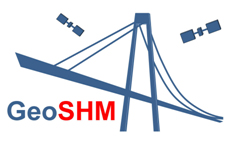
Objectives of the service

The objective of the study is to determine the technical feasibility and economic viability of the integrated use of multiple space assets for the structural health monitoring of bridges.
GeoSHM will provide the following information to the end users:
- Real-time 3D displacement and acceleration data streams at key locations on the structure using GNSS;
- Precise synchronisation of terrestrial sensors with GNSS time tags using fibre-optics;
- Slow subsidence characteristics of the supporting structures provided by satellite Interferometric SAR (InSAR) data;
- Estimates of long-term bridge motion, such as affected by thermal expansion, using integrated GNSS and InSAR data;
- Deformation estimates of a wide area of land surrounding the bridge using an integrated GNSS and InSAR solution.
Users and their needs
GeoSHM is a system that will appeal to a multitude of infrastructure operators and owners. In order to maximise the potential impact of the system and also its attractiveness to the target markets, it is essential that a range of stakeholders are engaged. Involving users and stakeholders ensures that proposed GeoSHM is functional and accurate. Users and stakeholders include: highways agencies, transport and bridge authorities/owners, maintenance service providers and Original Equipment Manufacturers (OEM).
Specific users/stakeholders include:
- Bridgemasters and Infrastructure Managers
- Forth Road Bridge
- Humber Bridge
- Skanska
- Yangtze River Bridge
- Engineering and Maintenance Contractor
- Strainstall
- Flint and Neill
- Telespazio VEGA UK Ltd
- Transport Research London
- SCISYS
- Smithers Purslow
- OEM
- Leica Geosystems
- Public Authority
- London Borough of Hammersmith and Fulham
- London Highways
- Dissemination, Media, Industry Bodies & Networks
- National Physical Laboratory
- Critical Software
Service/ system concept
The GeoSHM service will consist of:
- Data collection from multiple on-bridge sensors
- Time synchronisation of data
- Collection and processing of InSAR images for deformation monitoring:
- Large area environmental overview
- Input for post-event analysis, long term monitoring and SHM
- Data processing: Resulting in bridge deformation information
- Delivery of information to end users:
- Real-time SHM, and early warning of structural issues
- Post-event analysis of bridge behaviour for engineers and bridge operators
Space Added Value
The use of GNSS in SHM is commonplace, although the utilisation of its strengths is not high. The GeoSHM project will develop this aspect to make GNSS positioning a cornerstone of SHM. EO technology will be exploited to provide a thorough environment overview of the structural health of long span bridges and better define the expected maintenance schedule.
Current Status
The GeoSHM Feasibility Study has been successfully completed and its final review meeting was held on 12 March 2015. During this final meeting GeoSHM consortium summarised the achievements and discussed the existing issues and lessons learnt. They had also presented their plan to develop GeoSHM into the next stage.
During the GeoSHM FS a monitoring system that consists of dedicated communication system, four permanently installed GNSS receivers and three anemometers have been installed on the Forth Road Bridge (FRB). The installation on the FRB will stay for further test during demonstration project. Synthetic Aperture Radar images have been acquired of the surrounding area of the FRB and analysed with UNOTT’s in-house software pack PUNNET, which won the Copernicus Masters award in 2014.
It has proven that even with a limited monitoring system the Bridgemaster of the FRB could fully understand the loading and response effect under normal loading conditions and can also easily identify unusual deformations when there were extreme weather conditions.
EO data have proved to be extremely useful and confirm that over the years there are no significant movements on the supporting towers and surrounding areas. When analysed in China, EO images have shown ground subsidence around bridge sites located in two mega cities – Shanghai and Wuhan in China, that was caused by the underground engineering and water extractions.
During GeSHM FS two stakeholder workshops had been held to identify the end-users real needs and requirements which are fully reflected in the designing of the monitoring system that not only produces data but most importantly generates essential information for bridgemasters to assist them for decision-making practice The workshops were also used to disseminate the preliminary findings of GeoSHM FS. In September 2013 UNOTT organised an international deformation monitoring conference – JISDM 2013 that was attended by more than 200 people to promote GeoSHM which has attracted many potential users/stakeholders attention. Following the workshop, a Chinese bridge owner (BRDI) will join the next stage of GeoSHM development.
Prime Contractor(s)
Subcontractor(s)






